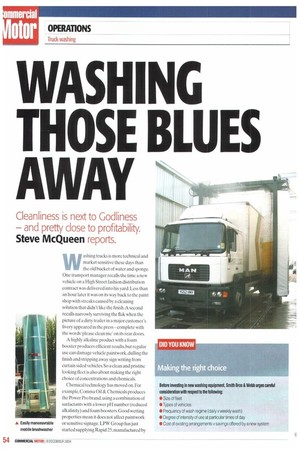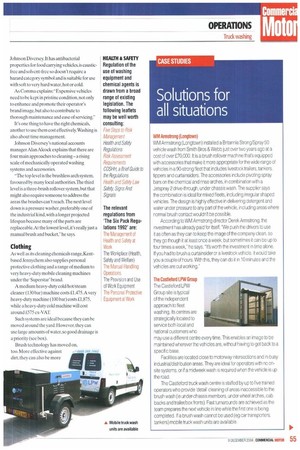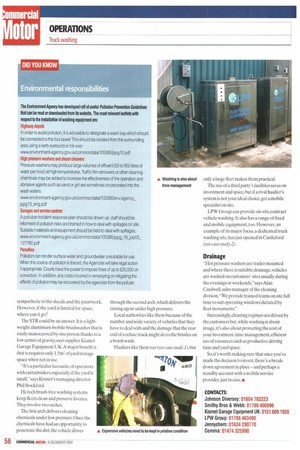WASHING THOSE BLUES AWAY **4ks*
Page 56

Page 57

Page 58

If you've noticed an error in this article please click here to report it so we can fix it.
Cleanliness is next to Godliness — and pretty close to profitability.
Steve McQueen reports.
Washing trucks is more technical and market sensitive these days than the old bucket of water and sponge. One transport manager recalls the time a new vehicle on a High Street fashion distribution contract was delivered into his yard. Less than an hour later it was on its way back to the paint shop with streaks caused by a cleaning solution that didn't like the finish.A second recalls narrowly surviving the flak when the picture of a dirty trailer in a major customer's livery appeared in the press complete with the words 'please clean me' on its rear doors.
A highly alkaline product with a foam booster produces efficient results. but regular use can damage vehicle paintwork, dulling the finish and stripping away sign writing from curtain sided vehicles. So a clean and pristine looking fleet is also about making the right choice of concentrations and chemicals.
Chemical technology has moved on. For example,Comma Oil & Chemicals produces the Power Pro brand, using a combination of surfactants with a lower pH number (reduced alkalinity) and foam boosters. Good wetting properties mean it does not affect paintwork or sensitive signage. LPW Group has just started supplying Rapid 25, manufactured by Johnson Diversey.It has antibacterial properties for food carrying vehicles, is causticfree and solvent-free so doesn't require a hazard category symbol and is suitable for use with soft to very hard water, hot or cold.
As Comma explains: 'Expensive vehicles need to be kept in pristine condition, not only to enhance and promote their operator's brand image, hut also to contribute to thorough maintenance and ease of servicing."
It's one thing to have the right chemicals, another to use them cost effectively. Washing is also about time management.
Johnson Diversey's national accounts manager Alan Alcock explains that there are four main approaches to cleaning — a rising scale of mechanically operated washing systems and accessories.
"The top level is the brushless arch system, favoured by many local authorities. The third level is a three-brush rollover system,but that might also require someone to address the areas the brushes can't reach. The next level down is a pressure washer, preferably one of the industrial kind, with a longer projected lifespan because many of the parts are replace able.At the lowest level, it's really just a manual brush and bucket," he says.
Clothing
As well as its cleaning chemicals range, Kentbased Jennychem also supplies personal protective clothing and a range of medium to very heavy-duty mobile cleaning machines under the 'Superstar' brand.
A medium heavy-duty cold/hot/steam cleaner (130 bar) machine costs £1,475.A very heavy-duty machine (100 bar) costs 11,875, while a heavy-duty cold machine will cost around £575 ex-VAT.
Such systems are ideal because they can be moved around the yard. However, they can use large amounts of water, so good drainage is a priority (see box).
Brush technology has moved on, too. More effective against -9800 389 ' dirt, they can also be more sympathetic to the decals and the paintwork. However, if the yard is limited for space, where can it go?
The STR could be an answer. It is alightweight aluminium mobile brushwasher that is easily manoeuvred by one person thanks to a low centre of gravity, says supplier Kismet Garage Equipment UK.A major benefit is that is requires only 1.5m2 of yard storage space when not in use.
"It's a particular favourite of operators with curtainsiders, especially if the yard is small.says Kismet's managing director Phil Stockford.
Hi-tech brush-free washing systems keep fleets clean and preserve liveries. They involve two arches.
The first arch delivers cleaning chemicals under low pressure. Once the chemicals have had an opportunity to penetrate the dirt, the vehicle drives through the second arch, which delivers the rinsing agent under high pressure.
Local authorities like them because of the number and wide variety of vehicles that they have to deal with and the damage that the rear end of a refuse truck might do to the bristles on a brush wash.
Hauliers like them too (see case study 1), but only a large fleet makes them practical.
The use of a third party's facilities saves on investment and space, but if a rival haulier's system is not your ideal choice, get a mobile specialist on site.
LPW Group can provide on-site contract vehicle washing. It also has a range of fixed and mobile equipment, too. However, an example of its major focus, a dedicated truck washing site, has just opened in Castleford (see case study 2).
Drainage "Hot pressure washers are trailer mounted and where there is suitable drainage, vehicles are washed on customers' sites usually during the evenings or weekends," says Alan Cardwell, sales manager of the cleaning division. "We provide trained teams on site full time to suit operating windows dictated by fleet movements."
Increasingly, cleaning regimes are driven by the customers but, while washing is about image, it's also about protecting the cost of your investment. time management, efficient use of resources such as productive driving time and yard space.
So, it's worth making sure that once you've made the decision to invest, there's a breakdown agreement in place — and perhaps a standby account with a mobile service provider,just in case.•


























































































































































































